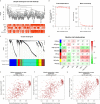Identification of Inflammation-Related Biomarker Lp-PLA2 for Patients With COPD by Comprehensive Analysis
- PMID: 34093570
- PMCID: PMC8176901
- DOI: 10.3389/fimmu.2021.670971
Identification of Inflammation-Related Biomarker Lp-PLA2 for Patients With COPD by Comprehensive Analysis
Abstract
Purpose: Chronic obstructive pulmonary disease (COPD) is a complex and persistent lung disease and lack of biomarkers. The aim of this study is to screen and verify effective biomarkers for medical practice.
Methods: Differential expressed genes analysis and weighted co-expression network analysis were used to explore potential biomarker. Gene Ontology (GO) enrichment, Kyoto Encyclopedia of Genes and Genomes (KEGG) analysis and Gene set enrichment analysis (GSEA) analysis were used to explore potential mechanism. CIBERSORTx website was used to evaluate tissue-infiltrating immune cells. Enzyme-linked immunosorbent assay (ELISA) was used to assess the concentrations of the Lp-PLA2 in serum.
Results: Ten genes were selected via combined DEGs and WGCNA. Furthermore, PLA2G7 was choose based on validation from independent datasets. Immune infiltrate and enrichment analysis suggest PLA2G7 may regulate immune pathway via macrophages. Next, Lp-PLA2(coded by PLA2G7 gene) level was upregulated in COPD patients, increased along with The Global Average of COPD (GOLD) stage. In additional, Lp-PLA2 level was significant correlate with FEV1/FVC, BMI, FFMI, CAT score, mMRC score and 6MWD of COPD patients. Finally, the predictive efficiency of Lp-PLA2 level (AUC:0.796) and derived nomogram model (AUC:0.884) in exercise tolerance was notably superior to that of the sit-to-stand test and traditional clinical features.
Conclusion: Lp-PLA2 is a promising biomarker for COPD patients and is suitable for assessing exercise tolerance in clinical practice.
Keywords: COPD; Lp-PLA2; PLA2G7; biomarker; exercise tolerance.
Copyright © 2021 Deng, Yin, Zhang, Zhou and Hou.
Conflict of interest statement
The authors declare that the research was conducted in the absence of any commercial or financial relationships that could be construed as a potential conflict of interest.
Figures







References
Publication types
MeSH terms
Substances
LinkOut - more resources
Full Text Sources
Medical
Miscellaneous

